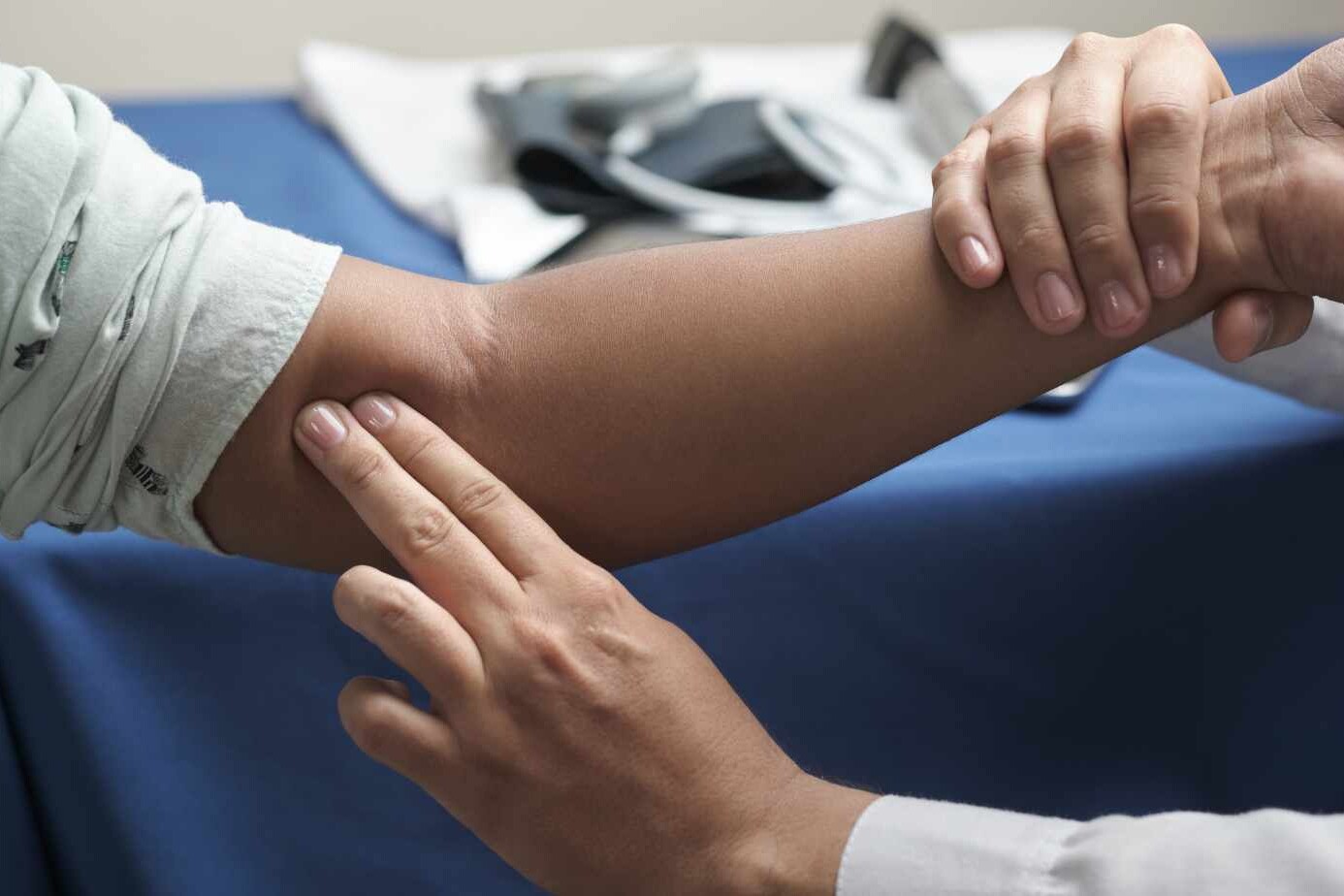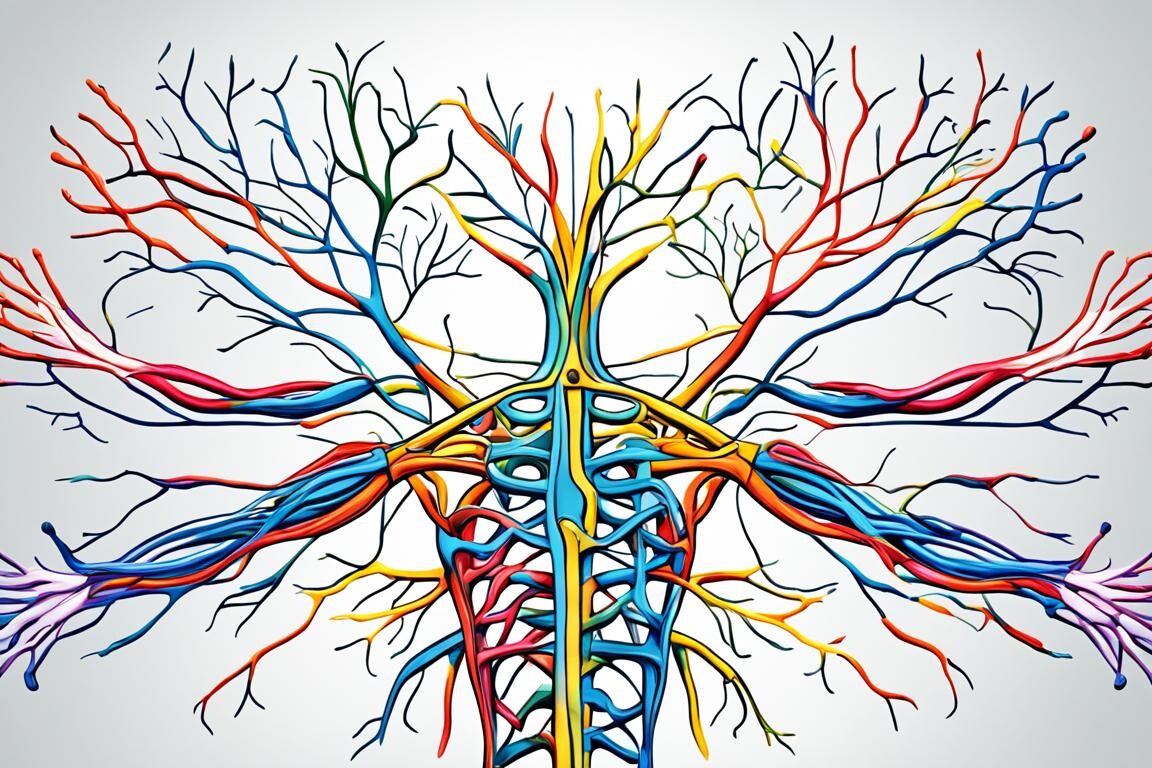Welcome to our article on brachial plexus injury newborn treatment. If your baby has been diagnosed with a brachial plexus birth palsy, also known as Erb’s palsy, we understand that you may have concerns and questions about the best course of action for their recovery. In this article, we will explore the different types of nerve injuries associated with brachial plexus injuries and discuss both nonsurgical and surgical treatment options.
A brachial plexus injury occurs when the network of nerves near the neck that control arm movement are damaged during birth. This can lead to weakness and loss of motion in the affected arm. However, it’s important to note that most infants with brachial plexus birth palsy can recover with the appropriate treatment and support.
In this article, we will delve into the types of nerve injuries that can occur in brachial plexus birth palsy, such as neurapraxia, neuroma, rupture, and avulsion. We’ll discuss the effectiveness of nonsurgical treatment options, including the crucial role of physical therapy and range-of-motion exercises in promoting recovery. We will also touch upon the circumstances where surgical intervention may be necessary for optimal outcomes.
Whether you’re seeking information about diagnosing brachial plexus birth palsy, understanding the different treatment options available, or learning about the prognosis for infants with this condition, we have you covered. We hope that this article provides you with the knowledge and guidance you need to make informed decisions regarding the treatment of your child’s brachial plexus injury.
Stay with us as we explore the various aspects of brachial plexus injury in newborns and the treatment options that can help your little one on their road to recovery.
Table of Contents
ToggleUnderstanding Brachial Plexus Injuries in Newborns
Brachial plexus birth palsy, also known as brachial plexus injury, occurs when the network of nerves near the neck that control arm movement are damaged during childbirth. These injuries can result in different types of nerve injuries, leading to various conditions such as Erb’s palsy, total plexus palsy, and Klumpke’s palsy.
Erb’s palsy is the most common type of brachial plexus injury, affecting the upper nerves in the brachial plexus. This condition causes weakness in the shoulder and biceps muscles, but hand function is usually preserved. Total plexus palsy, on the other hand, involves the damage of all five nerves in the brachial plexus, resulting in a complete loss of movement in the shoulder, arm, and hand. Klumpke’s palsy affects the lower roots of the brachial plexus and typically leads to weakness in the muscles of the hand.
To better understand the different types of brachial plexus injuries and their effects, refer to the table below:
| Type of Brachial Plexus Injury | Description |
|---|---|
| Erb’s Palsy | Affects upper nerves in the brachial plexus, causing weakness in the shoulder and biceps muscles |
| Total Plexus Palsy | Involves damage to all five nerves of the brachial plexus, resulting in a complete loss of movement in the shoulder, arm, and hand |
| Klumpke’s Palsy | Affects the lower roots of the brachial plexus and typically leads to weakness in the muscles of the hand |
Understanding the specific type of brachial plexus injury is crucial for determining the appropriate treatment plan and managing the condition effectively.
Types of Nerve Injuries and Treatment Options
Brachial plexus injuries can result in different types of nerve injuries. The severity of the injury determines the appropriate treatment options. Let’s take a closer look at each type of nerve injury and the corresponding treatment methods:
1. Neurapraxia:
Neurapraxia is the most common type of nerve injury in brachial plexus injuries. It occurs when the nerve is stretched but not torn. The good news is that neurapraxia typically heals on its own within 3 months. During this time, nonsurgical treatment options, such as physical therapy, can help promote recovery and restore functionality to the affected arm.
2. Neuroma:
Neuroma is a nerve injury that involves damage to the nerve fibers, leading to the formation of scar tissue. This scar tissue can partially hinder nerve function and result in limited arm movement. Nonsurgical treatments, including physical therapy and specialized exercises, are often recommended to improve range of motion and promote partial recovery.
3. Rupture:
Rupture occurs when the nerve is torn, and it does not heal on its own. Surgical intervention may be necessary to repair the ruptured nerve and restore proper nerve function. The specific surgical procedure will depend on the extent of the injury and may involve nerve grafts or transfers to bridge the gap and reconnect the damaged nerves.
4. Avulsion:
Avulsion is the most severe type of brachial plexus injury, where the nerve is completely torn from the spinal cord. In cases of avulsion, surgery is often required to restore arm functionality. Nerve transfers or grafts may be used to reconnect the damaged nerves and reestablish the connection from the spinal cord to the affected arm.
In summary, non-surgical treatment options, such as physical therapy, play a crucial role in the recovery process for milder nerve injuries like neurapraxia and neuroma. However, for more severe injuries like rupture and avulsion, surgical treatment methods are often necessary to repair and restore nerve function.
It’s important to consult with a healthcare professional to determine the most appropriate treatment approach based on the specific type and severity of the nerve injury.
Diagnosing Brachial Plexus Birth Palsy
Diagnosing brachial plexus birth palsy involves a comprehensive evaluation by a pediatrician. The diagnosis is primarily based on a physical examination and the identification of weakness in the affected arm. During the examination, the doctor carefully assesses the range of motion, muscle strength, and reflexes in the arm. They may also conduct specific tests to elicit any signs of nerve damage or dysfunction.
Imaging tests are often recommended to further evaluate the extent of the injury and identify any associated complications. X-rays and MRI scans can provide detailed images of the bones, joints, and soft tissues in the neck and shoulder, showing any fractures, dislocations, or abnormalities.
In addition to physical examination and imaging tests, electromyogram (EMG) and nerve conduction study (NCS) are diagnostic procedures that can provide valuable information about the nerves and muscles involved. EMG measures the electrical activity of the muscles, while NCS assesses the conduction of nerve signals. These tests help determine the severity and extent of nerve damage.
Regular check-ups and evaluations are crucial in monitoring the progress of brachial plexus birth palsy. Nerves recover slowly, and the recovery timeline can vary for each individual. It’s important to remember that complete recovery may take up to 2 years.

Nonsurgical Treatment Options for Brachial Plexus Birth Palsy
Nonsurgical treatment is the main approach for managing brachial plexus birth palsy, and physical therapy plays a crucial role in the treatment process. Gentle range-of-motion exercises are initiated early-on, usually around 3 weeks of age, to maintain the range of motion in the shoulder, elbow, wrist, and hand. These exercises are essential in preventing joint stiffness and contracture, which can lead to permanent limitations in movement.
As a parent or caregiver, actively participating in your baby’s therapy by doing exercises with them at home is highly encouraged. Regular physical therapy sessions, both in the clinic and at home, are essential for optimal recovery. Here are some key aspects of the nonsurgical treatment options for brachial plexus birth palsy:
Physical Therapy
Physical therapy is a cornerstone in the treatment of brachial plexus birth palsy. Under the guidance of a skilled therapist, your baby will engage in a variety of activities and exercises aimed at improving strength, coordination, and range of motion.
Range-of-Motion Exercises
Range-of-motion exercises involve moving the affected limb through its full range of motion to maintain flexibility and prevent joint stiffness. These exercises should be gentle and performed regularly to promote optimal recovery.
Joint Contracture Prevention
Joint contracture occurs when the muscles, tendons, or ligaments surrounding a joint become tight and restrict movement. It is important to prevent joint contracture, as it can lead to permanent limitations in movement. Physical therapy and range-of-motion exercises are crucial in preventing joint contracture.
Home Exercises
Home exercises play a vital role in reinforcing the progress achieved during therapy sessions. Your therapist will provide you with specific exercises to perform with your baby at home, ensuring consistent improvement between therapy sessions.
By actively participating in your baby’s therapy and diligently following the recommended nonsurgical treatment options, you can help promote optimal recovery and improve their overall quality of life.

Surgical Treatment Options for Brachial Plexus Birth Palsy
In cases where nonsurgical treatments do not yield satisfactory results within the first 3 to 6 months, surgical intervention may be considered. Surgical procedures can offer effective solutions for restoring nerve function and improving arm mobility in infants with brachial plexus birth palsy.
Microsurgery Techniques
Microsurgery techniques play a vital role in repairing damaged nerves and restoring their functionality. Surgeons may utilize nerve grafts taken from other parts of the body, such as the sural nerve from the calf, to bridge the gap between the damaged area and the target nerves. The nerve graft acts as a conduit for nerve fibers to grow through, facilitating nerve regeneration.
Nerve transfers using donor nerves may also be employed in microsurgery. In this procedure, a healthy nerve that is not essential for normal function is redirected and connected to the damaged nerve. This enables the transfer of functional nerve fibers and can improve muscle strength and control in the affected arm.
Joint Contracture Release
Joint contractures, which occur due to muscle imbalance and immobilization, can limit the range of motion in the affected limb. Surgical treatment for brachial plexus birth palsy may involve releasing these joint contractures to improve mobility. Surgeons carefully assess the tightness of muscles and perform procedures to release contracted tissues or perform tendon lengthening.
Tendon Transfer
Tendon transfer is another surgical option for enhancing arm movement in cases of brachial plexus birth palsy. In this procedure, tendons from functional muscles are redirected and attached to other muscles experiencing weakness or paralysis. This transfer helps to restore the balance of muscle forces around the affected joint and improve functional movements.
Reduction of Joints and Osteotomy
In situations where joint dislocation or misalignment is present, surgical intervention may involve the reduction of joints or osteotomy. Surgeons carefully position bones and realign joints to restore stability, improve joint function, and correct deformities. These procedures aim to optimize limb alignment and functionality, allowing for smoother movement and better overall motor control.
Overall, surgical treatment options for brachial plexus birth palsy offer promising possibilities for infants with more severe cases or those who do not respond well to nonsurgical treatments. The specific surgical approach is tailored to individual circumstances and the extent of the injury, ensuring a customized treatment plan for each child.
Conclusion
Brachial plexus injuries in newborns can have a significant impact on their arm function, requiring prompt diagnosis and appropriate treatment for optimal recovery. In most cases, nonsurgical treatments such as physical therapy and range-of-motion exercises are effective in restoring movement and sensation in the affected arm. However, for severe cases or when nonsurgical treatments do not yield satisfactory results, surgical interventions may be necessary.
The prognosis for brachial plexus birth palsy is generally good, with the majority of infants recovering arm function. It is important for parents to actively participate in their child’s treatment journey, providing support and ensuring consistency in therapy. With early intervention and the right treatment approach, children with brachial plexus injuries can achieve the best possible outcomes.
If you suspect that your newborn may have a brachial plexus injury, it is essential to consult a healthcare professional who specializes in this condition. They can provide a comprehensive evaluation, determine the appropriate treatment plan, and guide you through the recovery process. Remember, timely intervention and diligent treatment can make a significant difference in your child’s quality of life.
FAQ
What is brachial plexus injury in newborns?
Brachial plexus injury, also known as Erb’s palsy or brachial plexus birth palsy, is a condition that affects the network of nerves near the neck that give rise to the nerves of the arm. It is often caused by a difficult delivery or excessive stretching of the baby’s neck.
How common is brachial plexus birth palsy?
About 1 or 2 out of every 1,000 babies are affected by brachial plexus birth palsy.
What are the symptoms of brachial plexus birth palsy?
The main symptoms include arm weakness and loss of motion. However, most infants with this condition can recover with the help of physical therapy and other treatments.
What are the types of brachial plexus injuries in newborns?
Brachial plexus injuries can be classified into different types based on the type of nerve injury and the pattern of nerves involved. The most common type is Erb’s palsy, which affects the upper nerves in the brachial plexus. Total plexus palsy is another type where all five nerves of the brachial plexus are involved. Klumpke’s palsy affects the lower roots of the brachial plexus.
What are the different types of nerve injuries associated with brachial plexus birth palsy?
Brachial plexus injuries can result in different types of nerve injuries, including neurapraxia, neuroma, rupture, and avulsion.
How is brachial plexus birth palsy diagnosed?
Brachial plexus birth palsy is usually diagnosed by a pediatrician based on weakness in the affected arm and a physical examination. Imaging tests and electromyogram (EMG) and nerve conduction study (NCS) may also be done to assess the extent of the damage.
What are the nonsurgical treatment options for brachial plexus birth palsy?
Nonsurgical treatments, including physical therapy and range-of-motion exercises, play a crucial role in the recovery process. These treatments help maintain the range of motion in the affected arm and prevent joint stiffness and contracture.
When is surgical intervention necessary for brachial plexus birth palsy?
Surgical intervention may be considered if nonsurgical treatments do not yield satisfactory results within the first 3 to 6 months. Microsurgery techniques may be used to repair damaged nerves and improve arm function.
Source Links
About The Author

This article is medically reviewed by Dr. Chandril Chugh, Board-Certified Neurologist, providing expert insights and reliable health information.
Dr. Chandril Chugh is a U.S.-trained neurologist with over a decade of experience. Known for his compassionate care, he specializes in treating neurological conditions such as migraines, epilepsy, and Parkinson’s disease. Dr. Chugh is highly regarded for his patient-centered approach and dedication to providing personalized care.
→ Book a consultation to discover which remedies suit your needs best.




